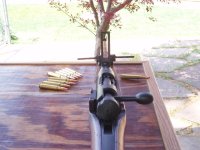Micropterus
New member
This is my Arisaka Type 99 "Last Ditch" rifle. This particular example was picked up by my grandfather's brother in Japan after the surrender. Apparently, there were piles of them for the soldiers to take. Other than 60+ years of closet wear and tear, I'm not sure this rifle was ever issued. The stock and metal finsih seem particularly good. He also picked up the bayonet. Both the bayonet and the rifle bear the Nagoya symbol.
I have two questions.
What "series" is this rifle?
And more pressing, the bolt is locked closed. This appears to be a rather common problem with these rifles. The bolt has about 1/8" of movement. There are no obvious welds holding it shut. I've tried the internet remedies to open the bolt - to no avail. Any suggestions?
Big pictures. So I am posting links.
Arisaka Type 99 1
Arisaka Type 99 2
Arisaka Type 99 3
Arisaka Type 99 4
Arisaka Type 99 5
Arisaka Type 99 6
Arisaka Type 99 7
Arisaka Type 99 8
Arisaka Type 99 9
Arisaka Type 99 10
Arisaka Type 99 11
Arisaka Type 99 12
Arisaka Type 99 13
Arisaka Type 99 14
Arisaka Type 99 15
I have two questions.
What "series" is this rifle?
And more pressing, the bolt is locked closed. This appears to be a rather common problem with these rifles. The bolt has about 1/8" of movement. There are no obvious welds holding it shut. I've tried the internet remedies to open the bolt - to no avail. Any suggestions?
Big pictures. So I am posting links.
Arisaka Type 99 1
Arisaka Type 99 2
Arisaka Type 99 3
Arisaka Type 99 4
Arisaka Type 99 5
Arisaka Type 99 6
Arisaka Type 99 7
Arisaka Type 99 8
Arisaka Type 99 9
Arisaka Type 99 10
Arisaka Type 99 11
Arisaka Type 99 12
Arisaka Type 99 13
Arisaka Type 99 14
Arisaka Type 99 15

